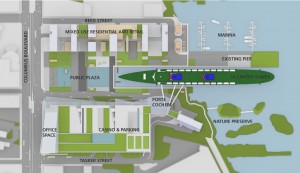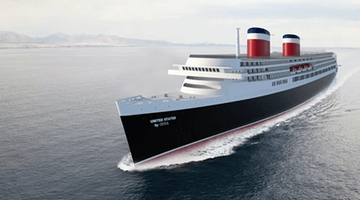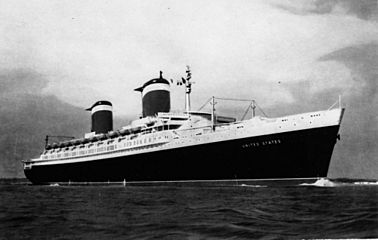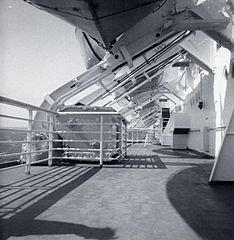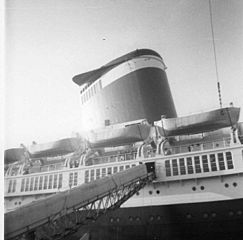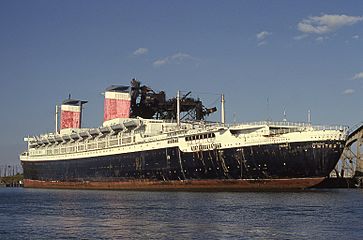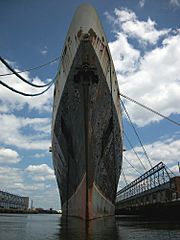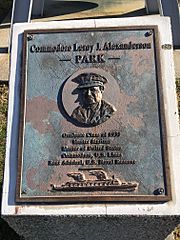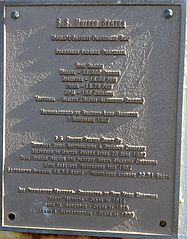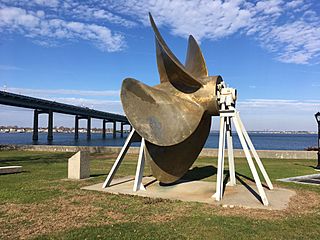SS United States facts for kids

United States docked at Pier 82 in Philadelphia, 2017
|
|
Quick facts for kids History |
|
|---|---|
| Name | United States |
| Owner | SS United States Conservancy |
| Operator | United States Lines |
| Port of registry | New York City |
| Route | Transatlantic |
| Ordered | 1949 |
| Builder | Newport News Shipbuilding and Drydock Company |
| Cost | $79.4 million($674 million in 2021 ) |
| Yard number | Hull 488 |
| Laid down | February 8, 1950 |
| Launched | June 23, 1951 |
| Christened | June 23, 1951 |
| Maiden voyage | July 3, 1952 |
| Out of service | November 14, 1969 |
| Identification |
|
| Nickname(s) | "The Big U" |
| Fate | Laid up in Philadelphia, Pennsylvania, US |
| Status | Sold in 1978 |
| Owner | Various |
| Acquired | 1978 |
| Fate | Laid up in Philadelphia in 1996. |
| Notes | United States changed ownership multiple times from 1978 to 1996 |
| Owner | SS United States Conservancy |
| Acquired | February 1, 2011 |
| Status | Laid up in Philadelphia |
| Notes | Continual fundraising towards conservation efforts since 2011. |
| General characteristics | |
| Class and type | Ocean liner |
| Tonnage | 53,330 GRT |
| Displacement |
|
| Length |
|
| Beam | 101.5 ft (30.9 m) maximum |
| Draft |
|
| Depth | 75 ft (23 m) |
| Decks | 12 |
| Installed power | |
| Propulsion |
|
| Speed | |
| Capacity | 1,928 passengers |
| Crew | 900 |
|
SS United States (Steamship)
|
|
| Location | Pier 82, Philadelphia, Pennsylvania |
| Architect | William Francis Gibbs |
| NRHP reference No. | 99000609 |
| Added to NRHP | June 3, 1999 |
The SS United States is a famous ocean liner built in 1950–51. It cost about $79.4 million to build for the United States Lines. This ship is the largest ocean liner ever built entirely in the United States. It is also the fastest ship to cross the Atlantic Ocean. The United States still holds the Blue Riband award for the highest average speed since its first trip in 1952.
William Francis Gibbs, an American naval architect, designed the ship. It was built so it could quickly be turned into a troopship for the United States Navy during wartime. The United States carried passengers across the Atlantic regularly until 1969. It was never actually used as a troopship.
Since the 1970s, the ship has been sold many times. Each new owner tried to make money from it, but none succeeded. By 1994, most of the ship's inside parts were sold or removed. This included getting rid of hazardous waste like asbestos panels. In 1996, the ship was moved to Pier 82 on the Delaware River in Philadelphia, where it remains today.
Since 2009, a group called the SS United States Conservancy has been working to save the ship. They bought it in 2011. They have made several plans to fix up the ship, like turning it into a complex with hotels and restaurants. In 2015, when they were low on money, they even thought about selling the ship for scrap. However, enough donations came in to keep it safe. Large donations have helped the ship stay docked in Philadelphia while the group looks for ways to restore it.
Contents
Building the United States
Why the Ship Was Built
During World War II, British ships like the RMS Queen Mary and RMS Queen Elizabeth carried many US troops to Europe. This inspired the US government to build a large, fast merchant ship. This new ship would be able to carry many soldiers if there was another war.
William Francis Gibbs, a naval architect, designed the ship. The United States Navy and United States Lines worked together to build it. The US government paid $50 million of the $78 million cost. United States Lines paid the rest. In return, the ship was designed to be easily changed into a troopship in wartime. It could carry 15,000 troops or even be used as a hospital ship.
Safety First: Fire Prevention
In 1942, during World War II, a French ship called the SS Normandie caught fire. It was being changed into a troopship in New York. Millions of gallons of water were used to put out the fire, and the ship tipped over. Because of this disaster, the United States was designed with very strict fire safety rules.
To prevent fires, the designers used almost no wood inside the ship. This included the frame, decorations, and inner surfaces. Even the furniture and fabrics were specially made from glass, metal, or spun-glass fiber. This was to meet the US Navy's fireproofing rules. The ship also used asbestos panels in many places. Even the clothes hangers in the fancy cabins were made of aluminum. The grand piano in the ballroom was made of mahogany, but only after a test showed it would not catch fire easily.
How the Ship Was Built
The United States was built from 1950 to 1952. It was constructed at the Newport News Shipbuilding and Drydock Company in Newport News, Virginia. The ship's hull was built in a dry dock. The United States followed strict Navy rules. It had many separate sections and engine rooms. This was to help the ship survive if it was attacked during a war. A large part of the ship was built in pieces and then put together. The hull alone had 183,000 parts.
The ship's top part (superstructure) used more aluminum than any other project at that time. This made the ship much lighter. However, joining the aluminum to the steel decks was a challenge because of galvanic corrosion. The United States had the most powerful steam turbines of any merchant ship then. They produced 240,000 horsepower. This power went to four 18-foot-wide propellers. The ship could go backward at over 20 knots. It could also travel over 10,000 nautical miles without stopping. Its normal cruising speed was 35 knots.
Ship's Journey Through Time
Early Years: Breaking Records
On its first trip, from July 3–7, 1952, the United States broke a speed record. It crossed the Atlantic from New York to Bishop Rock in the UK in 3 days, 10 hours, and 40 minutes. Its average speed was 35.59 knots. This won the ship the famous Blue Riband award. On its way back, the United States also broke the westbound speed record. It returned to America in 3 days, 12 hours, and 12 minutes, averaging 34.51 knots. The ship's owners received the Hales Trophy in New York.
The exact top speed of the United States was once a military secret. Some engineers claimed it reached 43 knots during trials. However, other sources say its highest sustained speed was 35 knots.
End of Passenger Service
By the late 1960s, fewer people were traveling across the Atlantic by ship. Air travel became more popular. Other famous liners like the Queen Mary and Queen Elizabeth were retired. The United States was no longer making money. In 1969, while the ship was being fixed up, United States Lines decided to take it out of service. The ship stayed docked for a few years, then moved to Norfolk, Virginia. Over time, it was sold to different companies.
New Owners and New Ideas
In 1977, a group wanted to buy the ship to use it as a hotel and casino in Atlantic City. This plan did not happen. The next year, a developer bought the ship for $5 million. He hoped to turn it into a time share cruise ship. In 1979, Norwegian Cruise Line (NCL) thought about buying it for Caribbean cruises. But they bought another ship instead.
During the 1980s, the US Navy considered using the United States as a troopship or hospital ship. This plan was also dropped. In 1984, the ship's furniture and other items were sold at an auction to pay debts. Some of these items ended up in a restaurant in North Carolina.
The time-share cruise ship idea failed. In 1992, the ship was sold again for $2.6 million to a Turkish shipping family. The ship was then towed to Turkey and Ukraine. From 1993 to 1994, workers removed asbestos from the ship. This left the inside of the ship almost completely empty. In 1996, the United States was towed to South Philadelphia.
Efforts to Save the Ship
In 1997, Edward Cantor bought the ship for $6 million. In 1999, a group called the SS United States Conservancy helped get the ship listed on the National Register of Historic Places.
In 2003, Norwegian Cruise Line (NCL) bought the ship. They wanted to fix it up and use it for their American-flagged Hawaiian passenger service. The United States is one of the few ships that can be used for this service. This is because of a law that says ships used for domestic travel must be built and flagged in the US. NCL studied the ship and said it was in good condition. They even found over 100 boxes of the ship's original plans. In 2006, the chairman of Star Cruises (NCL's owner) said the United States would return to service.
However, NCL America used other ships for its Hawaiian service. In 2009, it was reported that the United States would be sold. The SS United States Conservancy was formed to save the ship. They raised money to buy it. A philanthropist named H. F. Lenfest promised to match donations. Former US president Bill Clinton, who sailed on the ship in 1968, also supported saving it.
In March 2010, NCL announced they were taking bids to sell the ship for scrap. It cost about $800,000 a year to keep the ship afloat. The Conservancy bought the ship from NCL in February 2011 for $3 million. This was possible with money from H.F. Lenfest. The group had enough funds for about 20 months. They planned to clean the ship and make it self-supporting, possibly as a hotel. They looked at locations in Philadelphia, New York City, and Miami.
In November 2010, the Conservancy announced a plan to build a "multi-purpose waterfront complex" with hotels, restaurants, and a casino in South Philadelphia. But this plan fell apart in December 2010.
Recent Plans and Challenges
The SS United States Conservancy officially owned the ship on February 1, 2011. They continued talks about placing the ship in Philadelphia, New York City, or Miami. In New York, they talked about making the ship part of a $3.3 billion waterfront plan. In Miami, a group wanted to put the ship near the American Airlines Arena. With another $5.8 million donation from H. F. Lenfest, the Conservancy had about 18 months to make the ship a public attraction.
In August 2011, the Conservancy said placing the ship in Philadelphia was "not likely to work." However, talks continued for New York City. The grant from Lenfest required that the ship's restoration be done in the Philadelphia Naval Shipyard.
In February 2012, work began to prepare the ship for restoration. In April 2012, the Conservancy started looking for a developer for the ship. In July 2012, they launched an online campaign called "Save the United States." People could donate money to sponsor parts of a virtual ship. Donors would be featured on a "Wall of Honor" on the future museum inside the ship.
By late 2012, a developer was supposed to be chosen. The ship was planned to be in a city by summer 2013. In 2013, the ship began a "below-the-deck" makeover to make it more attractive to developers. In January 2014, old parts of the ship were sold to help pay the $80,000-a-month maintenance costs. This bought them six more months. New York City was still the most likely location.
In August 2014, the ship was still in Philadelphia, costing $60,000 a month. It was thought it would cost $1 billion to return the ship to sea. In September 2014, a final push was made to move the ship to New York City. A developer was interested in turning it into a waterfront destination. The Conservancy had only weeks to decide if the ship needed to be sold for scrap. In December 2014, agreements were announced to cover three months of costs. In February 2015, another $250,000 donation helped plan an onboard museum.
By October 2015, the Conservancy was looking into selling the ship for scrap. They were running out of money for the $60,000 monthly costs. Ideas for the ship included hotels, restaurants, or office space. One idea was to put computer servers in the lower decks. But no firm plans were made. The Conservancy said if no progress was made by October 31, 2015, they would have to sell the ship. However, $100,000 was raised in October, saving the ship for a short time. By November 2015, over $600,000 in donations had been received. This bought more time for the Conservancy to find a redevelopment plan.
Recent Developments
On February 4, 2016, Crystal Cruises announced they had an option to buy the SS United States. Crystal would pay for docking costs in Philadelphia for nine months. During this time, they would study if the ship could become a cruise ship based in New York City. On April 9, 2016, it was announced that 600 items from the United States would be returned to the ship. These items came from the Mariners' Museum and other donors.
On August 5, 2016, Crystal Cruises dropped their plan. They said there were too many technical and business problems. Crystal Cruises then donated $350,000 to help with the ship's preservation. The SS United States Conservancy continued to receive donations. In January 2018, the Conservancy asked US President Donald Trump for help. If the group runs out of money, they might sink the ship as an artificial reef instead of scrapping it.
On September 20, 2018, the Conservancy talked with Damen Ship Repair & Conversion. This company had turned another ocean liner, the SS Rotterdam, into a hotel.
On December 10, 2018, the Conservancy announced they were working with RXR Realty. This company would explore ways to restore the ocean liner. RXR Realty had shown interest in turning a ship into a hotel and event space in New York. The Conservancy wants any plan to keep the ship's original look. It must also include about 25,000 square feet for a museum on board. RXR's statement said they would consider different locations for the ship.
In March 2020, RXR Realty shared plans to turn the ocean liner into a 600,000 square foot hotel and cultural space. They asked cities like Boston, New York, Philadelphia, and Miami if they were interested.
Ship's Special Items
The ship's inside decorations included a children's playroom designed by Edward Meshekoff. Other art was made by Charles Gilbert. His work included glass panels in the ballroom. These panels had etched sea creatures and plants, highlighted with gold and silver.
The ship used four huge propellers, each weighing 60,000 pounds. Two had four blades, and two had five blades.
- One four-bladed propeller is at the entrance to the Intrepid Sea, Air & Space Museum in New York City.
- The other four-bladed propeller is outside the American Merchant Marine Museum in Kings Point.
- One five-bladed propeller is near the water at SUNY Maritime College in Fort Schuyler, New York.
- The other five-bladed propeller is at the entrance of the Mariner's Museum in Newport News, Virginia. It is still attached to a 63-foot-long drive shaft.
The ship's bell is kept in the clock tower at Christopher Newport University in Newport News, Virginia. It is rung for special events, like when new students arrive and when graduates leave.
Speed Records and Legacy
The United States won the Blue Riband by setting both eastbound and westbound speed records. This was the first time a US ship held the record in 100 years. The United States kept a speed of 30 knots across the North Atlantic for 17 years. No other ship challenged its Blue Riband record during its career.
Many people believe the story of the Blue Riband ended with the United States. This is because fast transatlantic passenger travel moved to air travel. The United States' eastbound record has been broken since 1986 by other vessels. Its westbound record was broken in 1990. However, these ships were not passenger-carrying ocean liners. The Hales Trophy itself was lost in 1990 to a commercial vessel called Hoverspeed Great Britain.
Gallery
-
SS United States disembarking at Le Havre, 1964
-
SS United States in dock at Pier 86 in New York the morning of July 31, 1964 sailing to Le Havre and Southampton
-
SS United States laid up in Hampton Roads, 1989
-
Prop, looking to the northwest. Throgs Neck Bridge in background.
Images for kids
-
SS United States docked at Pier 82 in Columbus Boulevard, Philadelphia, on July 16, 2017
See also
 In Spanish: SS United States para niños
In Spanish: SS United States para niños






